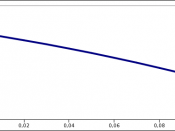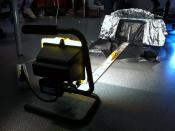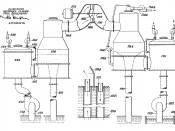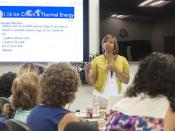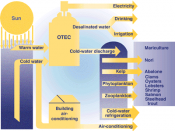Just Add Water
Priya Patel
January 16, 2009
Period 7
Lab Partners:
Bria Metivier
Alexa DaSilva
Ian Donohue
Omar El-Hely
Steven Pavick
Purpose: To determine how much thermal energy is transferred from hot water to cold water
Hypothesis: My hypothesis is that some of the thermal energy from the hot water will be transferred into the cold water. The amount of thermal energy will stay the same, because whatever thermal energy is lost from the hot water, will be found in the cold water.
Materials: hot water
cold water
2 calorimeters
2 beakers
2 thermometers
2 scales
Procedure: See attached.
Data/ Observations:
Calorimeters | Mass of Cup (g) | Mass of Cup and Water (g) | Mass of Water (g) | Starting Temperature (C) | Final Temperature (C) | Temperature Change (C) |
Hot Water | 7.1 | 195.2 | 188.1 | 73 | 47 | 26 |
Cold Water | 6.9 | 198.2 | 191.3 | 24 | 47 | 23 |
Thermal Energy Into Cold Water (J) | Thermal Energy Out of Hot Water (J) |
18391.58 | 20442.71 |
Conclusion: The purpose of this lab was to determine how much thermal energy is transferred from hot water to cold water.
In this lab, we figured out how much thermal energy is transferred from hot water to cold water. The amount of thermal energy that transferred into the cold water was 18391.58J. The amount of thermal energy that came out of the hot water was 20442.71J. Based on my group's results, my hypothesis was partially correct. I hypothesized that some of the thermal energy from the hot water would be transferred into the cold water. Also, the amount of thermal energy would remain the same, because the thermal energy lost from the hot water was going to be found in the cold water. This hypothesis was confirmed based on the results displayed in the second chart. Some thermal energy did leave the hot water and entered the cold water. But the amount of thermal energy did not remain the same. The amount of thermal energy leaving the hot water is more than the thermal energy entering the cold water, so some thermal energy was lost. Different types of errors could have affected the results of the lab. A major error that could've changed our results was if we took the thermometer out of the calorimeters too quickly. To prevent this error from happening, the lab could've been redesigned. There could've been a step that we had to leave the thermometer in the calorimeter for exactly one minute. This entire lab dealt with the transfer of thermal energy. Thermal energy is the total potential and kinetic energy of the particles in an object. Through the transfer of thermal energy, the temperature of each water changed. The hot water's temperature change was 26C. The cold water's temperature change was 23C. These two changes are in a close range. I think that these changes happened because the final temperature averaged with the starting temperature was close, so the change in temperature was expected to be close to each other. This lab demonstrated the transfer of thermal energy between two cups of water with different temperatures.
